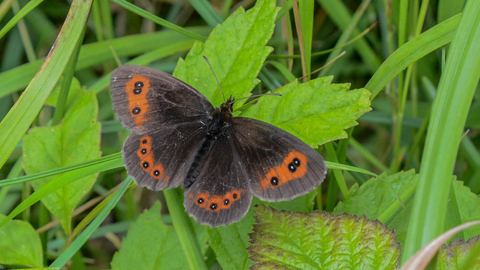
Scotch argus © Pete Richman
Scotch argus
Scientific name: Erebia aethiops
As the name suggests, this beautiful brown butterfly is most common in Scotland, though it can also be seen in northern England.
Species information
Category
Statistics
Wingspan: 4.4-5.2cmConservation status
Classed as Vulnerable on the Red List of British Butterflies (2021)
When to see
Adults fly from late July to early SeptemberAbout
Scotch argus butterflies are widespread in Scotland, where they live on damp grasslands, such as bogs and riverbanks, as well as in woodland clearings and young plantations. In northern England, they're found on sites with a mix of limestone grassland, scrub, and open woodland. The caterpillars feed on a variety of grasses, particularly purple moor-grass in Scotland and blue moor-grass in England.They're very tolerant of cool temperatures and can be one of the first butterflies to take to the wing early in the morning, as long as the sun is shining. Males tend to spend more time flying than females, which are often found basking on vegetation. In sunny weather, males fly restlessly over grassy areas looking for a mate. On cooler, cloudier days, they may perch on grass stems and only take flight to investigate any passing brown butterflies.
Females lay their eggs singly on grass stems or nearby plants in sunny, sheltered spots. The caterpillars emerge a few weeks later and feed on the tips of grasses. They then spend the winter tucked away in the leaf litter at the base of a plant, before emerging in spring and continuing to feed until they're fully grown. The caterpillars then pupate in a thin cocoon on the ground, in moss or other soft material.
How to identify
The upper surfaces of the wings are a rich velvety brown, darker than those of a meadow brown. Each wing has an orange patch containing a row of black spots with white centres. The undersides are a paler brown, with light bands across the hindwing and an orange patch with white-centred black spots on the forewing.Caterpillars are a pale brownish-green and covered with short, bristle-like hairs.
